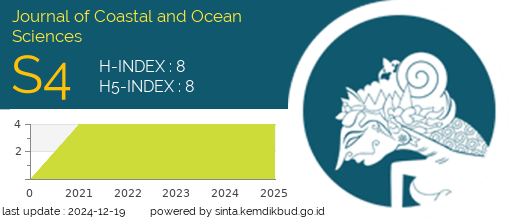Assessment of Fisheries Management Status with Ecosystem Approach on Bagan Boat Ship in Bungus Waters
DOI:
https://doi.org/10.31258/Keywords:
Fishing Techniques, PPS Bungus, Likert, EAFMAbstract
EAFM or Ecosystem Approach for Fisheries Management is a concept of how to balance socio-economic goals in fisheries management while still considering knowledge, information and uncertainty about biotic, abiotic and human interactions in aquatic ecosystems through a comprehensive and sustainable integrated fisheries management. The fishery potential is quite large in Bungus waters and the continuous fishing activities carried out by boat lift fishermen lead to overfishing; therefore fisheries management is very necessary to realize sustainable fisheries, especially for fishery commodities. The purpose of this study was to determine the status of the management of the bagan boat fishery in Bungus pps. This research was conducted in February 2022 at the Samudra Bungus Fishing Port, West Sumatra. The method used in this study uses the method issued by the National Working Group EAFM.DIT SDI KKP; the data taken are primary data and secondary data. Analysis of the data used using an ordinal-based likert scoring with a scoring assessment of 1,2,3. The greater the value, the better the EAFM that has been run. The results of the study show that the management of capture fisheries in the fishing technique domain at PPS Bungus is still lacking in implementing EAFM with a composite value of 18.8
Downloads
References
[FAO] Food and Agriculture Organization. (2003). The Ecosystem Approach to Fisheries. FAO Technical Guidelines for Responsible Fisheries. Rome(IT): FAO.
[KKP] Kementerian Kelautan Perikanan. (2021). kkp.go.id/artikel/31008-potensi-tuna-besar-menteri-trenggono-minta-aktivitas-usaha-di-pps-bungus-ditingkatkan diakses 16 September 2021
Anugerah, Y., Nurani, T.W., Sondita, M.F.A. (2016). Kompetensi Nelayan Rawai Tuna ditinjau dari Standar Kompetensi Kerja Nasional Indonesia (SKKNI) di PPN Palabuhanratu, Jurnal Sosial Eknomi Kelautan dan Perikanan, 11(2), 251-265.
Baihaqi, B., & Hufiadi, H. (2016). Kapasitas Penangkapan Pancing Ulur Tuna di Kepulauan Banda Neira. Jurnal Penelitian Perikanana Indonesia, 19, (2), 97-103
Budhiman, A., Christijanto, H., Kamarijah, S., Budoyo, G. H., Habibi, A., Musthofa, I., Adrianto, L., Bessie, D. M., Irawan, A., Ali, S., Abrahamsz, J., Halili. (2012). Penilaian Performa Pengelolaan Perikanan menggunakan Indikator EAFM: Kajian Pilot Test pada Beberapa Jenis Perikanan di Indonesia. Jakarta: Direktorat Sumberdaya Ikan, Direktorat Jenderal Perikanan Tangkap, Kementrian Kelautan dan Perikanan, WWFIndonesia dan Pusat Kajian Sumberdaya Pesisir dan Lautan Institut Pertanian Bogor.
Charles, A. T. 2001. Sustainable Fishery Systems.Blackwell Scientific Publications. Oxford. UK.
Fauzia, A. (2005). Kebijakan Perikanan dan Kelautan: Ise, Sintesis, Gagasan. Gramedia. Jakarta
Laporan Tahunan PPS Bungus Tahun 2021, diakses tanggal 2 September 2022, pukul 13.00 wib.
Sugiyono. 2010. Metode Penelitian Kuantitatif dan Kualitatif & RND. Alfabeta. Bandung






